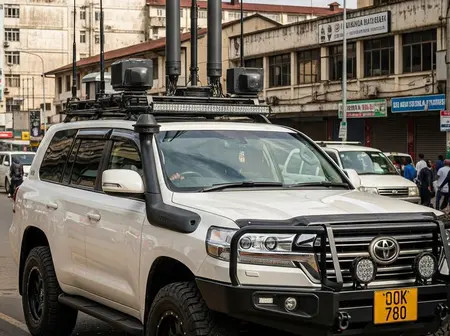When a president travels, whether within the country or abroad, there is far more happening behind the scenes than what the public sees. Among the most critical layers of protection are devices known as signal jammers.
These tools silently block certain wireless signals, helping to prevent security breaches and possible attacks.
In this article, we will look at what signal jammers are, how they work, the security threats they are designed to stop, the possible effects on nearby people and devices, and examples from both Kenya and around the world.
A signal jammer is a device that disrupts communication by sending out radio waves on the same frequencies used by mobile phones, Wi-Fi, GPS, or other wireless systems.
2025-08-13T03:59:00+00:00
2025-08-14T08:01:40+00:00
2025-08-13T12:37:57+00:00
By flooding these frequencies with stronger signals, the jammer prevents devices in the area from receiving or sending information.
Some jammers are portable and can fit inside a vehicle, while others are larger and installed in buildings or mounted on mobile units.
High-grade jammers can block multiple types of communication at the same time, making them ideal for high-security situations such as protecting a head of state.
One of the main dangers during a presidential visit is the possibility of an explosive device being triggered remotely through a mobile phone, radio, or other wireless connection.
Signal jammers cut off these communication channels, making it much harder for attackers to detonate such devices from a distance.
In recent years, drones have been used for spying and even carrying out attacks. A signal jammer blocks the control signals between the drone and its operator, forcing it to land or return to where it came from.
This helps keep the airspace above motorcades, venues, and residences secure.
GPS jamming prevents unauthorised tracking of the president’s movements. Without GPS, it becomes difficult for potential attackers to know the exact location of the target.
In some cases, jammers can also send false location data to mislead anyone attempting to follow.
Signal jammers can also block Wi-Fi, Bluetooth, and mobile connections to stop the use of hidden microphones, cameras, or other electronic spying devices in sensitive areas.
In Kenya, details of presidential security are not openly shared for obvious reasons. However, it is common during presidential visits for people nearby to suddenly lose mobile or internet connection.
This can happen when the president is passing through or attending an event. It is a discreet but effective way of ensuring that no remote communication can be used to compromise security.
Similar measures are believed to be used when hosting visiting heads of state or during major international summits held in the country.
Globally, the use of signal jammers is well-established in presidential and VIP protection. Countries with advanced security systems deploy them for motorcades, public speeches, and even in secure buildings.
Some militaries also use large-scale jammers to protect convoys and bases in conflict zones.
During global summits, such as G20 meetings, jammers are often part of a wider network of security technology to ensure that no unauthorised communications can occur near the venue.
While signal jammers are powerful tools for safety, they can cause inconvenience to the public. People close to the jamming zone may find their calls drop suddenly or their internet connection stop working.
Security systems such as Wi-Fi cameras, smart locks, or alarms that rely on wireless connections may temporarily go offline. This can create vulnerabilities for nearby businesses or homes if the disruption is prolonged.
Another challenge is the effect on emergency services. In a jamming zone, calls to ambulances, police, or fire services might not go through unless special measures are in place.

Leave a Reply